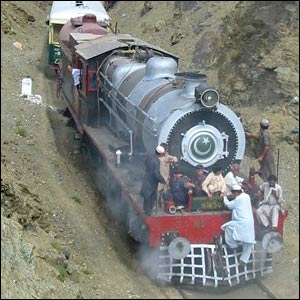
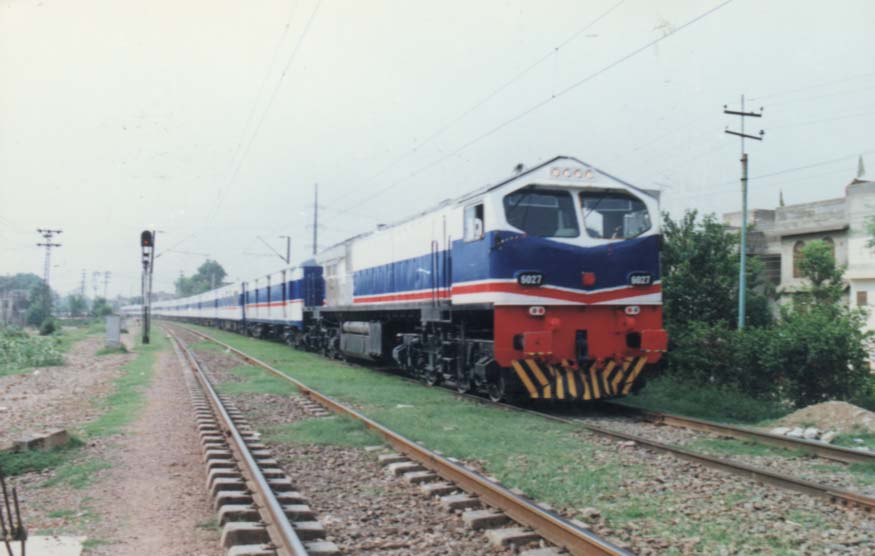

PAKISTAN RAILWAYS


From Steam Engines to Fast Track Trains
Stretched over 8,800 kilometres, Pakistan's railway network constitutes the backbone of its transportation system and plays a pivotal role in the country's economy. Pakistan Railways provides an important mode of Transportation in the farthest corners of the country and brings them closer for Business, sight seeing, pilgrimage and education. It has been a great integrating force and forms the life line of the country by catering to its needs for large scale movement of people and freight.
Bolan Express - Photo Courtesy Commoner28th
The possibility of Karachi as a sea port was first felt in the mid of 19th century and Sir Henry Edward Frere who was appointed Commissioner of Sind after its annexation with Bombay in 1847 sought permission from Lord Dalhousie to begin survey of sea port. He also initiated the survey for Railway line in 1858 . It was proposed that a railway line from Karachi City to Kotri, steam navigation up the Indus /Chenab up to Multan and from there an other railway to Lahore and beyond be constructed. Sir Bartle Frere, who was the then Commissioner of Scinde (Sindh) did the ground breaking of the project on April 29, 1858. The ceremony included him pushing a wheel-barrow full of construction material at the site of a railway embankment in Karachi. In 1859, two small stretches of Railway Line were opened in Karachi. One of this track section still exists while the other one has been uprooted.
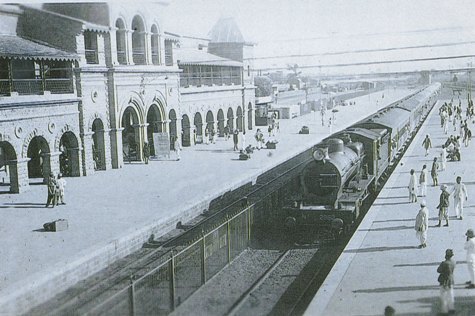
A year 1900 view of the Karachi-Kemari Train
Thus, it was on 13th May,1861 that first railway line was opened for public traffic between Karachi City and Kotri, the distance of 105 miles. The line between Karachi City and Keamari was opened on 16.6.1889.By 1897 the line from Keamari to Kotri was doubled. The 4 sections i.e. Scinde railways, Indian Flotilla company Punjab railway and Delhi railways working in a single company were later on amalgamated into Scinde, Punjab & Delhi railways company and was purchased by the Secretary of State for India in 1885 and in January, 1886 it was named North Western State Railways which was later on renamed as North Western Railways. Read more about further developments on introduction of railways in Scind (Sindh).
The railway line from Peshawar to Karachi closely follows Alexander’s line of march through the Hindu Kush to the sea. Different sections on existing main line from Peshawar to Lahore and Multan and branch lines were constructed in the last quarter of 19th century and early years of 20th century. At the time of partition, North Western Railway’s 1847 route mile was transferred to India leaving route miles 5048 to Pakistan. In 1954 The railway line was extended to Mardan and Charsada section and in 1956 Jacababad-Kashmore 2’-6’’ line was converted into broad gauge. Kot Adu-Kashmore line was constructed between 1969 to 1973 providing an alternate route from Karachi to up country.
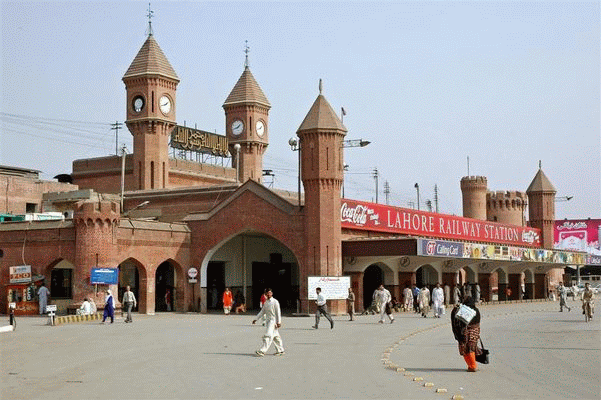
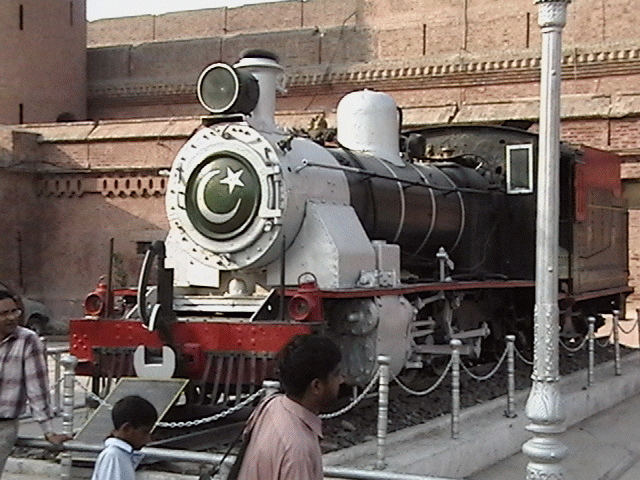
Left: Lahore Railway Station (stands as it was built by the British) - Right: The Steam Engine finally resting outside Lahore Railway Station
Today, Pakistan Railway comprises 8,775 route km, 781 stations and 42 trains halts. It has a fleet of 546 diesel electric locomotives, 25,815 wagons and 2,099 passenger coaches. Pakistan Railways is multi system and operates on three gauges, i.e. broad gauge, meter-gauge and narrow gauge. Maintenance is provided by three major locomotive workshops and thirty-five smaller workshops. Signaling facilities at important stations are track circulated within interlocking limits. Most routes have VHF radio coverage for communication between train dispatchers and trains. Telephone Communication is over wire lines and microwave. Freight traffic during the past five years has averaged 5-6 million tones per annum. It was 15 million tones per annum in the 1960 but trucking has steadily taken over the freight market. The volume of freight traffic in 1995/96 was approximately 5.1 billion-km. PR carried about 145 million passengers per annum in the 1970 but during the past five years, it has dropped to 70 million per annum. However the average distance per kilometre has increased from 80 km in the 70's to about 260 km today.
Balochistan Express en' route to Quetta (left) Over Hauling of a Burnt Engine (right - read inset below) - Photos Courtesy Commoner28th
| There is something special about the Engine hauling this train. After the violent riots on account of tragic murder of Mohtarma Benazir Bhutto on 27th Dec 2007, this engine was pulling the fateful Chiltan Express, burnt near Bakhsha Pur Station. The engine was declared scrap but the railway workers at the diesel shop Quetta, without any extra resource rehabilitated the engine within just 10 days, saving the country almost 60 Million PKR. |
Due to resource constraints, though, Pakistan Railways has fallen behind in routine and periodic maintenance, leading to deterioration of the entire infrastructure. Tracks are in poor condition, necessitating speed restrictions that result in undue delays and high transportation costs. Obsolete signaling and telecommunications equipment compromise travel safety and efficiency, and railway workshops lack the modern machinery needed to turn out enough spare parts. These deficiencies have led many businesses to shift their goods traffic from the railways to the country's already overtaxed road network. This loan will support an extensive scheme to modernize and increase the carrying capacity of the rail network. The project will address the various shortfalls by re-commissioning locomotives that are no longer fit for use, renovating or purchasing new rolling stock, in particular freight and high capacity oil-tank wagons, restoring severely deteriorated stretches of track, and modernizing plant and machinery at a number of workshops. These efforts will serve to expand the network's carrying capacity, and improve speed and safety standards.
Modernization Activities: The major emphasis of Pakistan Railways has been on the replacement of overage assets. Due to resource constraint, however, it is now engaged in modernizing certain areas as best as it can. These include the following:-
To ensure more comfortable journey it has been decided to manufacture only lower class air-conditioned coaches in future.
All second class coaches are being provided with cushioned seats.
Reservation work has been computerized on modern lines at Lahore and Karachi stations; the system's two major reservation centres. Computerization of reservation offices of Peshawar, Rawalpindi, Faisalabad, Multan and Hyderabad is in progress and is likely to be commissioned shortly. The steps are now underway to link these stations with other major railway stations.
Closed circuit televisions have been introduced at Lahore, Karachi, Multan and Faisalabad railway stations. This entertainment is being extended to Sukkur, Rawalpindi and Peshawar stations in the next phase. Subak Kharam and Shalimar trains have also been provided with closed circuit televisions and this system is being provided in Subak Raftar also.
Public address system is being provided in Subak Raftar, Subak Kharam, Tezgam and Khyber Mail trains.
Modernization of Karachi, Quetta, Hyderabad, Multan, Lahore, Faisalabad, Rawalpindi and Peshawar Railway stations, removal of hindrances on railway platforms and upgradation of approach roads are being carried out.
Private Sector is being encouraged to participate in the activities of the system. As a first step, ticket selling and ticket checking on Lahore-Faisalabad and Lahore-Narowal-Sialkot Sections have been privatized.
Feasibility study for a high-speed track is in hand.
Development Schemes: The Pakistan Railways has proposed major replacement and rehabilitation schemes for the forthcoming five year plan. An amount of Rs. 40 billion has been allocated for ongoing and new works. The major physical components which would be completed during the Plan period includes:
Doubling of track from Lodhran to Peshawar (800 Km) to ensure sustained improvement in the turn round time of rolling stock and motive power;
Manufacture of 51 locomotives;
Rehabilitation of 101 diesel electric locomotives;
Manufacture of 175 new design light-weight passenger coaches;
Equipping 7000 wagons with roller bearing;
Revamping of 14 electric locomotives;
Procurement of 1400 high capacity wagons;
Procurement of 50 wagon movers;
Introduction of Management Information System;
Improvement and Rehabilitation of track to cater for high speeds;
Telecommunication and Signaling Network on main and important branch lines.
Today, plans are afoot to introduce bullet-train type train service between Karachi and Lahore. Although a gigantic project for countries like Pakistan, but every new idea starts from a dream and this dream may not take long to materialize.
|
Related Links: | Train Timings | Pakistan railway Academy | Pakistan - Railway Data | Khyber Steam Safari | |
|
| HOME PAGE | AIR LINKS | PORTS AND SEA LINKS | ROAD NETWORK | TELECOM | Copyright©JalalsPages - 2005 - 2009 |